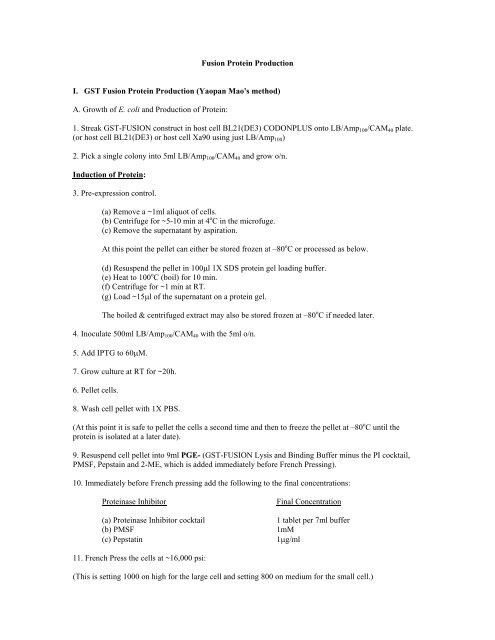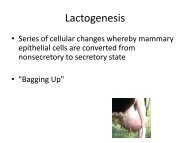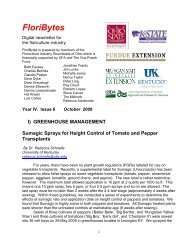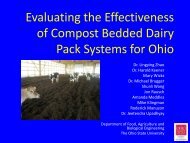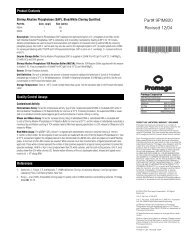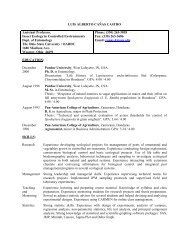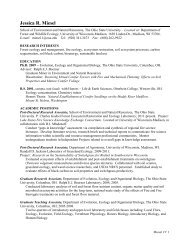GST Fusion Protein Production
GST Fusion Protein Production
GST Fusion Protein Production
You also want an ePaper? Increase the reach of your titles
YUMPU automatically turns print PDFs into web optimized ePapers that Google loves.
<strong>Fusion</strong> <strong>Protein</strong> <strong>Production</strong><br />
I. <strong>GST</strong> <strong>Fusion</strong> <strong>Protein</strong> <strong>Production</strong> (Yaopan Mao's method)<br />
A. Growth of E. coli and <strong>Production</strong> of <strong>Protein</strong>:<br />
1. Streak <strong>GST</strong>-FUSION construct in host cell BL21(DE3) CODONPLUS onto LB/Amp 100 /CAM 40 plate.<br />
(or host cell BL21(DE3) or host cell Xa90 using just LB/Amp 100 )<br />
2. Pick a single colony into 5ml LB/Amp 100 /CAM 40 and grow o/n.<br />
Induction of <strong>Protein</strong>:<br />
3. Pre-expression control.<br />
(a) Remove a ~1ml aliquot of cells.<br />
(b) Centrifuge for ~5-10 min at 4 o C in the microfuge.<br />
(c) Remove the supernatant by aspiration.<br />
At this point the pellet can either be stored frozen at –80 o C or processed as below.<br />
(d) Resuspend the pellet in 100µl 1X SDS protein gel loading buffer.<br />
(e) Heat to 100 o C (boil) for 10 min.<br />
(f) Centrifuge for ~1 min at RT.<br />
(g) Load ~15µl of the supernatant on a protein gel.<br />
The boiled & centrifuged extract may also be stored frozen at –80 o C if needed later.<br />
4. Inoculate 500ml LB/Amp 100 /CAM 40 with the 5ml o/n.<br />
5. Add IPTG to 60µM.<br />
7. Grow culture at RT for ~20h.<br />
6. Pellet cells.<br />
8. Wash cell pellet with 1X PBS.<br />
(At this point it is safe to pellet the cells a second time and then to freeze the pellet at –80 o C until the<br />
protein is isolated at a later date).<br />
9. Resuspend cell pellet into 9ml PGE- (<strong>GST</strong>-FUSION Lysis and Binding Buffer minus the PI cocktail,<br />
PMSF, Pepstain and 2-ME, which is added immediately before French Pressing).<br />
10. Immediately before French pressing add the following to the final concentrations:<br />
<strong>Protein</strong>ase Inhibitor<br />
(a) <strong>Protein</strong>ase Inhibitor cocktail<br />
(b) PMSF<br />
(c) Pepstatin<br />
Final Concentration<br />
1 tablet per 7ml buffer<br />
1mM<br />
1µg/ml<br />
11. French Press the cells at ~16,000 psi:<br />
(This is setting 1000 on high for the large cell and setting 800 on medium for the small cell.)
12. Add DTT to 1mM and Triton X-100 to 1%.<br />
13. Incubate on ice 40min.<br />
14. Spin cell debris down at 20,000 X g (13,000 rpm in the Sorval SS34 rotor) for 20min.<br />
15. Collect the s/n and aliquot it away for storage at -80 o C.<br />
16. Determine the protein concentration by Bradford assay.<br />
17. Load 50-100µg of the crude E. coli protein extract onto a Laemmli protein gel.<br />
B. <strong>Protein</strong> Purification<br />
1. Prepare the glutathione agarose:<br />
(a) Weigh out the required quantity of glutathione agarose (Sigma cat# 4510).<br />
From a 500ml culture of <strong>GST</strong>-FUSION resuspended in 10 ml and French pressed, approximately 2mg of<br />
r<strong>GST</strong>-FUSION can be expected. Approximately 10mg of <strong>GST</strong> protein will bind to 1ml of swollen<br />
glutathione agarose. The required glutathione agarose bed volume is then only 250µL (Mao used 1.0 ml<br />
of the French Press lysate with 60µL of glutathione agarose beads). The small polypropylene columns<br />
hold approximately 2.5ml of settled bed resin, which can therefore be used to purify up to 25mg of target<br />
protein.<br />
(b) Add 1.0 ml sterile 1X PBS per 88mg of glutathione agarose. Alternatively add 10 ml of sterile 1X<br />
PBS to the entire vial of glutathione agarose (which if the vial states 10ml, that means there is 880mg in<br />
that vial).<br />
(c) Incubate at 4 o C overnight to swell the glutathione agarose. Unswollen glutathione agarose is stored at<br />
–20 o C but once it is hydrated do not freeze it. It is stable at 4 o C for ~ 1month. If longer storage is required<br />
add EtOH to 20%. Glutathione agarose is rather expensive so don’t waste it.<br />
Column Method:<br />
2. Thaw the E. coli protein extract on ice.<br />
3. Transfer the volume of swollen glutathione agarose to be used to a sterile polypropylene screw cap tube<br />
and equilibrate the glutathione agarose with 1X PGE- by adding 10X volumes of 1X PGE-. (If working<br />
with relatively small volumes of glutathione agarose and proteins extracts, then it may be easier to perform<br />
all of these steps in a microfuge tube.)<br />
4. Decant off the liquid fraction.<br />
5. Add the E. coli protein extract to the 1X PGE- equilibrated glutathione agarose. Incubate at 4 0 C with<br />
gentle shaking or rotation for ~90 min. Once the glutathione agarose is added to the column, allow it to<br />
settle by gravity. Open the column and allow the buffer to drain from the column. A flow rate of ~ 10<br />
column volumes per hour is supposedly optimal for efficient protein purification; too fast a flow rate will<br />
result in increased impurities in the eluted fraction.<br />
6. Wash the glutathione agarose resin with 10 volumes of 1X PGE+.<br />
7. Wash the glutathione agarose resin with 10 volumes of 1X PGE Wash Buffer. Repeat the wash for a<br />
total of three washes (1 wash with 1X PGE+ and 2 washes with 1X PGE Wash Buffer).<br />
Stockinger Lab; Version 02/16/01
Note that if the objective were simply a purification of recombinant protein then the <strong>GST</strong> fusion protein<br />
could now be eluted off of the glutathione agarose resin by using a very small volume (~0.5ml) of 5mM<br />
reduced glutathione (Sigma cat # G 6529) in 50mM Tris pH 8.0 (reduced glutathione competes with the<br />
r<strong>GST</strong>-FUSION fusion protein for binding to the glutathione agarose) or by cleavage at the fusion protein<br />
junction with the thrombin cleavage protease. If the objective is to capture other proteins that “stick” to the<br />
r<strong>GST</strong>-FUSION then the r<strong>GST</strong>-FUSION should be left attached to the column matrix and stored at 4 o C (for<br />
up to several days before use).<br />
Batch Method (alternative to and much easier than a column):<br />
2. Obtain a sterile 50ml (or 15ml) disposable polypropylene tube. (If working with relatively small volumes<br />
of glutathione agarose and proteins extracts, then it may be easier to perform all of these steps in a<br />
microfuge tube.)<br />
3. Transfer the required quantity of glutathione agarose to the sterile 50ml (or 15ml) disposable<br />
polypropylene tube. Allow the resin to settle by gravity. Decant off the supernatant.<br />
4. Wash the glutathione agarose with 10 volumes of sterile 1X PGE- (1X volume = settled bed resin<br />
volume). Gently invert the resin in buffer several times, allow the resin to settle by gravity and then decant<br />
off the supernatant (if desired the resin may be spun at very low (~ 500 X g; e.g., setting #1 in a clinical<br />
centrifuge).<br />
5. Add the crude E. coli protein extract to the glutathione agarose. Gently rock the protein lysate at 4 0 C for<br />
~90 min (e.g., lay the tube on its side on a bed of ice on a shaker). Allow the resin to settle by gravity and<br />
then decant off the supernatant.<br />
6. Add 10X volumes of 1X PGE+. Gently invert to mix. Allow the resin to settle by gravity and then<br />
decant off the supernatant.<br />
7. Add 10X volumes of 1X PGE Wash Buffer. Gently invert to mix. Allow the resin to settle by gravity<br />
and then decant off the supernatant. Repeat with a second 10X volume of 1X PGE Wash Buffer.<br />
A relatively pure preparation of r<strong>GST</strong>-FUSION should now be bound to the glutathione agarose. Verify<br />
this by removing a small aliquot (5- 10µL) of the glutathione agarose to which r<strong>GST</strong>-FUSION is supposed<br />
bound add 1/3 volume SDS loading dye and incubate at 68 o C for 10 minutes. Load this sample onto a<br />
protein gel. Store the <strong>GST</strong>-FUSION bound to glutathione agarose at 4 o C.<br />
Stockinger Lab; Version 02/16/01
II. HIS <strong>Fusion</strong> <strong>Protein</strong> <strong>Production</strong> (Eric’s method for making HIS-FUSIONs)<br />
A. Growth of E. coli and <strong>Production</strong> of <strong>Protein</strong>:<br />
1. Streak HIS-FUSION construct in host cell BL21(DE3) CODONPLUS onto LB/Kan 100 /CAM 40 plate.<br />
(or host cell BL21(DE3) using just LB/Kan 50 ).<br />
2. First thing in the morning pick a single colony into 5ml LB/Kan 50 /CAM 40 and grow for several hours at<br />
37 o C until visible growth. Or pick the o/n the night before.<br />
3. Inoculate 500ml LB/Kan 50 /CAM 40 with 0.5ml of the o/n. (If the 500 ml of LB was prewarmed to 37 o C<br />
then the E. coli will take off faster.)<br />
4. Shake at 37 o C until the OD reaches 1.0 (~ 3h). (If the o/n was picked the night before it was probably in<br />
stationary phase when inoculated into the 500 ml culture and as a consequence will likely take longer than<br />
the 3 hours to come up to an OD of 1.0.)<br />
I have also prepared protein from 30 o C and RT grown cultures as in Mao’s <strong>GST</strong> method.<br />
Induction of <strong>Protein</strong>:<br />
5. Pre-expression control.<br />
(a) Remove a ~1ml aliquot of cells.<br />
(b) Centrifuge for ~5-10 min at 4 o C in the microfuge.<br />
(c) Remove the supernatant by aspiration.<br />
At this point the pellet can either be stored frozen at –80 o C or processed as below.<br />
(d) Resuspend the pellet in 100µl 1X SDS protein gel loading buffer.<br />
(e) Heat to 100 o C (boil) for 10 min.<br />
(f) Centrifuge for ~1 min at RT.<br />
(g) Load ~15µl of the supernatant on a protein gel.<br />
The boiled & centrifuged extract may also be stored frozen at –80 o C if needed later.<br />
6. Add IPTG so that the final concentration in 1.0 mM. This induces gene & protein expression. However<br />
before adding the IPTG, remove an aliquot of cells (~1-5 ml) spin them down for later use as a pre IPTG<br />
control on a protein gel.<br />
7. Shake at 37 o C for 3h.<br />
8. Pellet cells.<br />
9. Wash cell pellet with 1X PBS.<br />
(At this point it is safe to pellet the cells a second time and then to freeze the pellet at –80 o C until protein<br />
isolations at a later date)<br />
10. Resuspend cell pellet into 9ml 1X HIS-tag binding buffer.<br />
11. Add 2 tablets Protease Inhibitor cocktail, PMSF to 1mM and Pepstatin to 1µg/ml.<br />
12. French Press the cells by passing the resuspended cells through the French press three times at 16,000<br />
PSI (1000 PSIG on the Aminco French Press using the large, (40K) cell).<br />
Stockinger Lab; Version 02/16/01
Alternatively I have washed, resuspended and French pressed the cells using 10 ml T 50 E 2 throughout. The<br />
EDTA chelates Mg and therefore proteases requiring Mg are inactivated. However the problem with EDTA<br />
is that if you are planning to purify the protein by passing it over a nickel column the EDTA needs to be<br />
dialyzed away because it also chelates Ni. Reducing agents such as 2ME and DTT must also be avoided<br />
when using Ni-affinity chromatography.<br />
13. Add Triton X-100 to 1%.<br />
14. Incubate on ice 40min.<br />
15. Spin cell debris down at 20,000g for 20min.<br />
16. Collect the s/n and aliquot it away for storage at -80 o C.<br />
Note: Often a precipitate forms once the HIS-FUSION preparations are French pressed. This seems to<br />
occur after storage of the protein extracts at 4 o C but most notably after the protein extracts have gone<br />
through a -80 o C freeze-thaw cycle. The reasons for this are not yet clear. It may be that these are merely<br />
inclusion bodies that precipitate out of solution. However this same phenomenon has been observed to<br />
occur after HIS-FUSION was purified by Ni-agarose affinity chromatography which suggests that it is not<br />
inclusion body precipitating and rather it is a solubility problem of the protein. (Mao observed similar a<br />
phenomenon when working with <strong>GST</strong>-AtGCN5.) When these precipitates were analyzed by protein<br />
electrophoresis it was found that they consisted mainly of a protein migrating to a position to where the<br />
rHIS-FUSION migrates. There may be clue in the Amersham and or Novagen recombinant protein<br />
overexpression manuals that will help resolve this problem.<br />
17. Determine the protein concentration by Bradford assay.<br />
18. Load 50-100µg of the crude E. coli protein extract onto a Laemmli protein gel.<br />
B. <strong>Protein</strong> Purification (column chromatography)<br />
1. Dilute the stock solutions of His-tag charge buffer, His-tag binding buffer and His-tag wash buffer to<br />
1X with sterile dH 2 0 before use.<br />
Column Method:<br />
2. Thaw the E. coli protein extract on ice.<br />
3. Gently mix the bottle containing His•Bind resin by inversion until it is completely suspended (stored at<br />
4 o C). The resin is 50% (v/v) in storage buffer (20% EtOH). Transfer the mixture to a small polypropylene<br />
column (BioRad cat# 731-1550). Allow the His•Bind resin to settle in the column. Open the column and<br />
allow the buffer to drain from the column. (The small polypropylene columns hold approximately 2.5ml of<br />
settled bed resin, which can be used to purify up to 20mg of target protein.)<br />
4. Once the level of storage buffer drops to the top of the column bed, use the following sequence of<br />
washes and buffer additions to charge and to equilibrate the column (where 1 volume is equivalent to the<br />
settled bed volume):<br />
(a) 3 volumes of sterile dH 2 0 (to remove EtOH).<br />
(b) 5 volumes of 1X His-tag charge buffer.<br />
(c) 3 volumes of 1X His-tag binding buffer.<br />
5. Allow the binding buffer to drain to the top of the column bed and then load the column with the<br />
prepared extract. (A flow rate of ~ 10 column volumes per hour is supposedly optimal for efficient protein<br />
purification; too fast a flow rate will result in increased impurities in the eluted fraction.)<br />
Stockinger Lab; Version 02/16/01
6. Wash the column with 10 volumes of 1X His-tag binding buffer.<br />
7. Wash the column with 6 volumes of His-tag wash buffer.<br />
Note that if the objective were simply a purification of recombinant protein then the protein could now be<br />
eluted off of the Ni-agarose resin by using 6 volumes of 1X His-tag elution buffer or by cleavage at the<br />
fusion protein junction with the thrombin cleavage protease. However if the objective is to capture other<br />
proteins that “stick” to the rFUSION then the rFUSION should be left attached to the column matrix.<br />
Batch Method (alternative to and much easier than a column)<br />
2. Obtain a sterile 50ml (or 15ml) disposable polypropylene tube.<br />
3. Transfer the required quantity of His•Bind resin to the sterile 50ml (or 15ml) disposable polypropylene<br />
tube. Allow the resin to settle by gravity. Decant off the supernatant. (If working with relatively small<br />
volumes of glutathione agarose and proteins extracts, then it may be easier to perform all of these steps in a<br />
microfuge tube.)<br />
4. Using the same volumes as for the column method above follow the same sequence of washes and<br />
equilibrations to prepare the column (again where 1 volume is equivalent to the settled bed volume). Gently<br />
invert the resin and buffer several times, allow the resin to settle by gravity, decant off the supernatant and<br />
then repeat using the next buffer (if desired the resin may be spun at 500 X g; e.g., ~ setting #1 in a clinical<br />
centrifuge.<br />
(a) 3 volumes of sterile dH 2 0 (to remove EtOH).<br />
(b) 5 volumes of 1X His-tag charge buffer.<br />
(c) 3 volumes of 1X His-tag binding buffer.<br />
5. Add the crude E. coli protein extract to the prepared resin. Gently rock the protein lysate at 4 0 C for ~90<br />
min (e.g., lay the tube on its side on a bed of ice on a shaker). Allow the resin to settle by gravity and then<br />
decant off the supernatant.<br />
6. Add 5X volumes of 1X His-tag binding buffer. Gently rock the protein lysate at 4 0 C for ~5 min. Allow<br />
the resin to settle by gravity and then decant off the supernatant. Repeat with a second 5X volumes of 1X<br />
His-tag binding buffer.<br />
7. Add 3X volumes of 1X His-tag wash buffer. Gently rock the protein lysate at 4 0 C for ~5 min. Allow the<br />
resin to settle by gravity and then decant off the supernatant. Repeat with a second 3X volumes of 1X Histag<br />
binding buffer.<br />
A relatively pure preparation of rHIS-FUSION should now be bound to the Ni-agarose. Verify this by<br />
removing a small aliquot (5-10µL) of the Ni-agarose to which rHIS-FUSION is supposed bound add 1/3<br />
volume SDS loading dye and incubate at 68 o C for 10 minutes. Load this sample onto a protein gel.<br />
Stockinger Lab; Version 02/16/01
III. Solutions and stuff:<br />
A Common solutions:<br />
1. LB Medium (500 ml)<br />
(a) Bacto Tryptone 5.0g<br />
(b) Yeast Extract 2.5g<br />
(c) NaCl 2.5g<br />
(d) pH with 10N NaOH to ~7 (I add one pellet of NaOH per 500 ml which adjusts the pH to ~7)<br />
(e) dH 2 O<br />
to 500ml<br />
(f) Agar<br />
15g<br />
(g) A/C<br />
20-30 min<br />
Cool media to ~50 o C. Add antibiotic and pour plates (it helps if a stir bar was included in the flask when<br />
autoclaved). Let plates cool. Invert plates after media solidifies. Incubate on bench o/n (helps plates to dry).<br />
Store plates in 4 o C. Amp plates only last 2-4 weeks. Kan will stay good for ~ year. The others?<br />
2. Antibiotics<br />
Prepare antibiotic by dissolving it in the appropriate solvent. Filter-sterilize each antibiotic by passing the<br />
solution through a syringe with attached 0.2µm filter sterilization unit. Collect the supernatant into sterile<br />
microfuge tubes or a 15ml sterile plastic conical tube. Antibiotics dissolved in MeOH or EtOH do not<br />
require filter sterilization. Store all antibiotics at –20 o C. The final concentration of antibiotic in the media is<br />
actually dependant upon the plasmid and the host. The following are general guidelines based on frequently<br />
used plasmids and the hosts, when in doubt ask first.<br />
Antibiotic Solvent Stock conc For 10ml of stock Final conc in media<br />
(a) Ampicillin H 2 O 50mg/ml 0.5g 100µg/ml<br />
(b) Chloramphenicol EtOH 34mg/ml 0.34g 34µg/ml<br />
(c) Gentamycin H 2 O 50mg/ml 0.5g 50µg/ml (Agro)<br />
(d) Kanamycin H 2 O 50mg/ml 0.5g 50µg/ml<br />
(e) Rifampicin MeOH 50mg/ml 0.5g<br />
(f) Streptomycin H 2 O 300mg/ml 3.0g 10µg/ml E. coli<br />
300µg/ml Agro<br />
(g) Tetracycline H 2 O/EtOH 12.5mg/ml 0.125g 15µg/ml<br />
(50/50)<br />
(h) Timenton H 2 O 300mg/ml 3.0g 300µg/ml Agro<br />
3. IPTG (Isopropylthio-β-D-galactoside) (2g/10ml = 0.84M)<br />
Stock<br />
IPTG<br />
dH 2 O<br />
2g<br />
8ml<br />
Bring final volume to 10 ml.<br />
Filter-sterilize using 0.2µm filter. Aliquot into m/f tubes & store at –20 o C.<br />
4. PBS (Phosphate Buffered Saline)<br />
Stock 10X Stock sol’n Final 1X []<br />
(1000ml)<br />
Stockinger Lab; Version 02/16/01
NaCl 80g 137mM<br />
KCl 2g 2.7mM<br />
Na 2 HPO 4 11.5g 4.3mM<br />
KH 2 PO 4 2g 1.4mM<br />
PH to 7.5<br />
F, a/c<br />
5. STE (Sodium chloride, Tris, EDTA)<br />
Stock Sol'n Final [ ]<br />
(a) 5M NaCl<br />
150mM<br />
(b) 1M Tris (7.9)<br />
10mM<br />
(c) 0.5M EDTA<br />
1.0mM<br />
(d) Glycerol 10%<br />
6. PMSF (Phenylmethylsulfonyl fluoride) and AEBSF (4-(2-amino-ethyl)- benzenesulfonyl fluoride<br />
hydrochloride), which is a non-toxic alternative to PMSF)<br />
Stock For 1 ml Final []<br />
PMSF (100mM) 17.4mg 1mM<br />
2-propanol (iso) 1.0 ml<br />
Store at –20 o C<br />
or<br />
AEBSF (100mM) 23.9mg 1mM<br />
dH 2 O<br />
1.0 ml<br />
Store at –20 o C<br />
7. Pepstatin A For 1 ml Final []<br />
Pepsatin A 1mg 1µg/ml<br />
Ethanol<br />
1ml<br />
8. DTT (Dithiolthreitol) 1M<br />
Stock For 10 ml Final []<br />
DTT 1.545g 1mM<br />
0.01M NaOAc 10ml<br />
(pH 5.2)<br />
Filter sterile. Store in 1.0 ml aliquots at –80 o C.<br />
(0.01M NaOAc is 33µl of 3M NaOAc in 9.67ml dH2O)<br />
9. Complete Mini, EDTA-free Protease inhibitor cocktail tablets (Roche Diagnostics Corp. cat # 1836170).<br />
B. Solutions for <strong>GST</strong> affinity chromatography:<br />
1. <strong>GST</strong>-CBF1 Lysis and Binding Buffer (Minus <strong>Protein</strong>ase inhibitor cocktail); PGE-<br />
Stock Sol'n Final [ ]<br />
Stockinger Lab; Version 02/16/01
(a) 10X PBS 1X<br />
(b) Glycerol 10%<br />
(c) EDTA<br />
1mM<br />
2. <strong>GST</strong>-CBF1 Lysis and Binding Buffer (Plus <strong>Protein</strong>ase inhibitor cocktail); PGE+<br />
Stock Sol'n Final [ ]<br />
(a) 10X PBS<br />
1X<br />
(b) Glycerol 10%<br />
(c) EDTA<br />
1mM<br />
Always add immediately before using.<br />
(d) <strong>Protein</strong>ase Inhibitor cocktail<br />
(e) PMSF<br />
(f) Pepstatin<br />
(g) DTT<br />
1 tablet per 7ml buffer<br />
1mM<br />
1µg/ml<br />
1mM<br />
3. <strong>GST</strong>-CBF1 Wash Buffer (1X PGE Wash Buffer)<br />
Stock Sol'n Final [ ]<br />
(a) 10X PBS<br />
1X<br />
(b) Glycerol 10%<br />
(c) EDTA<br />
1mM<br />
Add immediately before using (i.e., use fresh):<br />
(d) PMSF<br />
(f) Pepstatin<br />
(g) DTT<br />
1mM<br />
1µg/ml<br />
1mM<br />
3. <strong>GST</strong> <strong>Protein</strong>-<strong>Protein</strong> Interaction Binding Buffer (PPIBB)<br />
Stock Sol'n Final [ ]<br />
(a) 1M HEPES (7.5)<br />
40mM<br />
(b) 3M NaOAc<br />
100mM<br />
(c) 1M MgCl 2<br />
5mM<br />
(d) 1M KCl<br />
5mM<br />
(e) 0.5M EDTA<br />
1mM<br />
(f) 80% Glycerol 10%<br />
(g) Triton X-100 0.2%<br />
(h) BSA 1%<br />
(i) dH 2 O<br />
Add immediately before using (i.e., use fresh):<br />
(j) <strong>Protein</strong>ase Inhibitor cocktail<br />
(k) PMSF<br />
(l) Pepstatin<br />
(m) DTT<br />
1 tablet per 7 ml<br />
1mM<br />
1µg/ml<br />
1mM<br />
4. <strong>GST</strong> <strong>Protein</strong>-<strong>Protein</strong> Interaction Wash Buffer = PPIWB (PPIBB plus KCl to 100mM)<br />
Stockinger Lab; Version 02/16/01
Stock Sol'n Final [ ]<br />
(a) 1M HEPES (7.5)<br />
40mM<br />
(b) 3M NaOAc<br />
100mM<br />
(c) 1M MgCl 2<br />
5mM<br />
(d) 1M KCl 100mM *<br />
(e) 0.5M EDTA<br />
1mM<br />
(f) 80% Glycerol 10%<br />
(g) Triton X-100 0.2%<br />
(h) BSA 1%<br />
(i) dH 2 O<br />
Add immediately before using (i.e., use fresh):<br />
(j) <strong>Protein</strong>ase Inhibitor cocktail<br />
(k) PMSF<br />
(l) Pepstatin<br />
(m) DTT<br />
1 tablet per 7 ml<br />
1mM<br />
1µg/ml<br />
1mM<br />
C. Solutions for Ni-affinity chromatography:<br />
1. 8X His-Tag Charge Buffer:<br />
Stock 8X [] For 100ml 1X []<br />
NiSO 4 0.4M 10.48g 50mM<br />
dH 2 O<br />
to 100ml<br />
F, a/c<br />
2. 8X His-Tag Binding Buffer<br />
Stock 8X [] For 100ml 1X []<br />
Imidazole 0.04M 0.272g 50mM<br />
NaCl 4.0M 23.4g 0.5M<br />
Tris (pH 7.9) 160mM 16ml 1M (pH 7.9) 20mM<br />
dH 2 O<br />
to 100ml<br />
F, a/c<br />
3. 8X His-Tag Wash Buffer<br />
Stock 8X [] For 100ml 1X []<br />
Imidazole 0.48M 3.26g 60mM<br />
NaCl 4.0M 23.4g 0.5M<br />
Tris (pH 7.9) 160mM 16ml 1M (pH 7.9) 20mM<br />
dH 2 O<br />
to 100ml<br />
F, a/c<br />
4. 4X His-Tag Elution Buffer<br />
Stockinger Lab; Version 02/16/01
Stock 4X [] For 100ml 1X []<br />
Imidazole 4.0M 27.23g 1.0M<br />
NaCl 2.0M 11.7g 0.5M<br />
Tris (pH 7.9) 80mM 8ml 1M Tris (pH 7.9) 20mM<br />
dH 2 O<br />
to 100ml<br />
F, a/c<br />
5. 4X His-Tag Strip Buffer<br />
Stock 4X [] For 100ml 1X []<br />
EDTA 0.4M 80ml 0.5M EDTA 0.1M<br />
NaCl 2.0M 11.7g 0.5M<br />
dH 2 O<br />
to 100ml<br />
F, a/c<br />
6. 1X buffers:<br />
Dilute the stock solutions (either 8X or 4X) into the appropriate volume of sterile dH 2 O (or non sterile<br />
dH 2 O but then autoclave):<br />
For 100ml:<br />
Stock solution concentration<br />
8X<br />
4X<br />
Stock solution 12.5ml 25ml<br />
dH 2 O 87.5ml 75ml<br />
Notes:<br />
Read the Amersham Recombinant Handbook and pET Expression System Manual for ideas and help<br />
trouble shooting experiments.<br />
After French pressing the cells the fusion protein should be in the supernatant but per chance that it is either<br />
in an inclusion body or that the French press step did not work it may be in the pellet so don’t discard this<br />
immediately!<br />
BL21(DE3) E. coli are deficient in the ion protease and the ompT protease genes that may cause instability<br />
and degradation of recombinant proteins. The bacteriophage T7 RNA polymerase gene is harbored on the<br />
bacteriophage λ DE3 which is integrated into the bacterial chromosome of BL21. Expression of the T7<br />
RNA polymerase gene is repressed until the addition of IPTG. IPTG derepresses expression of the T7<br />
polymerase gene, which then transcribes the HIS-tagged gene fusion proteins. Note that the promoter in the<br />
<strong>GST</strong> fusion vectors is the tac promoter and which is under direct control of IPTG derepression; i.e., no T7<br />
RNA polymerase gene is required. The BL21 (DE3) CODONPLUS cells have an additional plasmid (under<br />
chloramphenicol selection) which overexpresses the E. coli argU, ileY and leuW tRNAs. These codons are<br />
used at a much higher frequency in other organisms than they are in E. coli and thus their overexpression<br />
helps to eliminate problems associated with difficult to express proteins resulting from these codon biases.<br />
Mao used the lower temperatures and the overnight IPTG induction to obtain maximal r<strong>GST</strong>-FUSION<br />
protein expression (Stockinger et al., 2001). Eric until 37 o C but waited until the cell OD reached 1.0 (or<br />
slightly higher) to obtain maximal rHIS-FUSION overexpression (Stockinger et al., 1997). Note that the<br />
<strong>GST</strong> vector uses ampicillin and the HIS (pET) vector uses kanamycin. β-lactamase (the product of the<br />
Stockinger Lab; Version 02/16/01
Amp r gene) is secreted into the medium and thus can confer amp resistance to a cell that does not have the<br />
amp r plasmid. In contrast, kan r gene product remains in the cell and cannot confer Kan r to neighboring<br />
cells.<br />
Any proteinase inhibitor should be handled with care. PMSF is extremely destructive to the mucus<br />
membranes of the respiratory tract, the eyes, and the skin. It may be fatal if inhaled, swallowed, or absorbed<br />
through the skin. In case of contact, immediately flush eyes or skin with copious amounts of water and<br />
discard contaminated clothing. PMSF is requires alcohol (isopropanol) for solubility while AEBSF is<br />
water-soluble and is supposedly non-toxic.<br />
DTT and/or 2ME and any metal chelating agents (EDTA) must not be used when using Ni-Agarose affinity<br />
chromatography (i.e., the HIS fusion system).<br />
Stockinger Lab; Version 02/16/01


